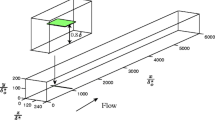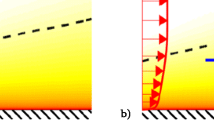Abstract
The effects of implementing a large-eddy break-up device (LEBU) in a turbulent boundary layer on the interaction with the boundary layer is investigated with particular emphasis on the turbulent/non-turbulent interface (TNTI). The simulation data is taken from a recent well-resolved large eddy simulation (Chin et al. Flow Turb. Combust. 98, 445–460 2017), where the LEBU was implemented at a wall-normal distance of 0.8 δ (local boundary layer thickness) from the wall. A comparison of the TNTI statistics is performed between a zero-pressure-gradient boundary layer with and without the LEBU. The LEBU is found to delay the growth of the turbulent boundary layer and also attenuates the fluctuations of the TNTI. The LEBU appears to alter the structure size at the interface, resulting in a narrower and shorter dominant structure (in an average sense). Further analysis beneath the TNTI using two-point correlations shows that the LEBU affects the turbulent structures in excess of 100 δ downstream of the LEBU.









Similar content being viewed by others
References
Townsend, A.A.: The Structure of Turbulent Shear Flow. Cambridge University Press, Cambridge (1956)
Corke, T.C., Guezennec, Y., Nagib, H.M.: Modification in Drag of Turbulent Boundary Layers Resulting from Manipulation of Large-Scale Structures. Tech. Rep. 3444, NASA CR (1981)
Gad-el-Hak, M.: Flow Control: Passive, Active, and Reactive Flow Management. Cambridge University Press, Cambridge (2000)
Klein, H., Friedrich, R.: Large-eddy simulation of manipulated boundary layer and channel flows. In: Coustols, E. (ed.) Turbulence Control by Passice Means, pp. 41–65. Kluwer Academic Publishers (1990)
Savill, A.M., Mumford, J.C.: Manipulation of turbulent boundary layers by outer-layer devices: skin-friction and flow-visualization results. J. Fluid Mech. 191, 389–418 (1988)
Bogard, D.G., Tiederman, W.G.: Burst detection with single-point velocity measurements. J. Fluid Mech. 162, 389–413 (1986)
Tardu, S., Binder, G.: Review: effect of the OLDs on near wall coherent structures; discussion and need for future work. In: Choi, K.-S. (ed.) Recent Developments in Turbulence Management, pp 147–160. Kluwer Academic Publishers, Norwell (1991)
Sahlin, A., Alfredsson, P.H., Johansson, A.V.: Direct drag measurements for a flat plate with passive boundary layer manipulators. Phys. Fluids 29, 696–700 (1986)
Sahlin, A., Johansson, A.V., Alfredsson, P.H.: The possibility of drag reduction by outer layer manipulators in turbulent boundary layers. Phys. Fluids 31, 2814–2820 (1988)
Chin, C., Monty, J., Hutchins, N., Ooi, A., Örlü, R., Schlatter, P.: Simulation of a large-eddy-break-up device (LEBU) in a moderate Reynolds number turbulent boundary layer. Flow Turb. Combust. 98, 445–460 (2017)
Walsh, M.J., Sellers III, W.L., McGinley, C.B.: Riblet drag at flight conditions. J. Aircraft 26, 570–575 (1989)
Hutchins, N., Marusic, I.: Evidence of very long meandering features in the logarithmic region of turbulent boundary layers. J. Fluid Mech. 579, 1–28 (2007)
Mathis, R., Hutchins, N., Marusic, I.: Large-scale amplitude modulation of the small-scale structures in turbulent boundary layers. J. Fluid Mech. 628, 311–337 (2009)
Schlatter, P., Li, Q., Örlü, R., Hussain, F., Henningson, D.S.: On the near-wall vortical structures at moderate Reynolds numbers. Eur. J. Mech. B-Fluid 48, 75–93 (2014)
Eitel-Amor, G., Örlü, R., Schlatter, P.: Simulation and validation of a spatially evolving turbulent boundary layer up to R e 𝜃 = 8300. Int. J. Heat Fluid Flow 47, 57–69 (2014)
Jimenez, J., Hoyas, S., Simens, M., Mizuno, Y.: Turbulent boundary layers and channels at moderate Reynolds numbers. J. Fluid Mech. 657, 335–360 (2010)
da Silva, C.B., dos Reis, R.: The role of coherent vortices near the turbulent/non-turbulent interface in a planar jet. Phil. Trans. Roy. Soc. Lond. A 26, 738–753 (2011)
Townsend, A.A.: The mechanism of entrainment in free turbulent flows. J. Fluid Mech. 26, 689–715 (1966)
da Silva, C.B., Hunt, J.C.R., Eames, I., Westerweel, J.: Interfacial layers between regions of different turbulence intensity. Annu. Rev. Fluid Mech. 46, 567–590 (2014)
Westerweel, J., Fukushima, C., Pedersen, J., Hunt, J.: Mechanics of the turbulent-nonturbulent interface of a jet. Phys. Rev. Let. 95, 174,501 (2005)
Westerweel, J., Fukushima, C., Pedersen, J., Hunt, J.: Momentum and scalar transport at the turbulent/non-turbulent interface of a jet. J. Fluid Mech. 631, 199–230 (2009)
Corrsin, S., Kistler, A.: Free-Stream Boundaries of Turbulent Flows. Tech. Rep. 1244, NASA (1955)
Mathew, J., Basu, A.: Some characteristics of entrainment at a cylindrical turbulence boundary. Phys. Fluids 14, 2065–2072 (2002)
Spalart, P.R., Streletsb, M., Travin, A.: Direct numerical simulation of large-eddy-break-up devices in a boundary layer. Int. J. Heat Fluid Flow 27, 902–910 (2006)
Schlatter, P., Örlü, R.: Assessment of direct numerical simulation data of turbulent boundary layers. J. Fluid Mech. 659, 116–126 (2010)
Chevalier, M., Schlatter, P., Lundbladh, A., Henningson, D.S.: SIMSON- a Pseudo-Spectral Solver for Incompressible Boundary Layer Flows. Tech. Rep. 7, Tech. Rep. TRITA-MEK (2007)
Schlatter, P., Stolz, S., Kleiser, L.: LES of transitional flows using the approximate deconvolution model. Int. J. Heat Fluid Flow 25, 549–558 (2004)
Inoue, M., Pullin, D.I.: Large-eddy simulation of the zero-pressure-gradient turbulent boundary layer up to R e Θ = O(1012). J. Fluid Mech. 686, 507–533 (2011)
Araya, G., Castillo, L.: Direct numerical simulations of turbulent thermal boundary layers subjected to adverse streamwise pressure gradients. Phys. Fluids 25, 095,107 (2013)
Schlatter, P., Örlü, R.: Turbulent boundary layers at moderate Reynolds numbers: inflow length and tripping effects. J. Fluid Mech. 710, 5–34 (2012)
Goldstein, D., Handler, R., Sirovich, L.: Modeling a no-slip flow boundary with an external force field. J. Comput. Phys. 366, 354–366 (1993)
Chauhan, K., Philip, J., de Silva, C., Hutchins, N., Marusic, I.: The turbulent/non-turbulent interface and entrainment in a boundary layer. J. Fluid Mech. 742, 119–151 (2014)
Örlü, R., Schlatter, P.: Comparison of experiments and simulations for zero pressure gradient turbulent boundary layers at moderate Reynolds numbers. Exp. Fluids 54, 1547 (2013)
Chauhan, K.A., Monkewitz, P.A., Nagib, H.M.: Criteria for assessing experiments in zero pressure gradient boundary layers. Fluid Dyn. Res. 41, 021,404 (2009)
Brown, G.L., Thomas, A.S.W.: Large structure in a turbulent boundary layer. Phys. Fluids 20, 243–252 (1977)
Acknowledgements
This research was undertaken with the assistance of resources provided at the NCI NF through the National Computational Merit Allocation Scheme supported by the Australian Government. Computer time was also provided by SNIC (Swedish National Infrastructure for Computing). The authors also acknowledge the financial support of the Australian Research Council as well as the Lundeqvist foundation. Financial support was also provided by the Wallenberg foundation via the Wallenberg Academy Fellow programme.
Author information
Authors and Affiliations
Corresponding author
Ethics declarations
Conflict of interests
The authors declare that they have no conflict of interest.
Rights and permissions
About this article
Cite this article
Chin, C., Örlü, R., Schlatter, P. et al. Influence of a Large-Eddy-Breakup-Device on the Turbulent Interface of Boundary Layers. Flow Turbulence Combust 99, 823–835 (2017). https://doi.org/10.1007/s10494-017-9861-7
Received:
Accepted:
Published:
Issue Date:
DOI: https://doi.org/10.1007/s10494-017-9861-7




